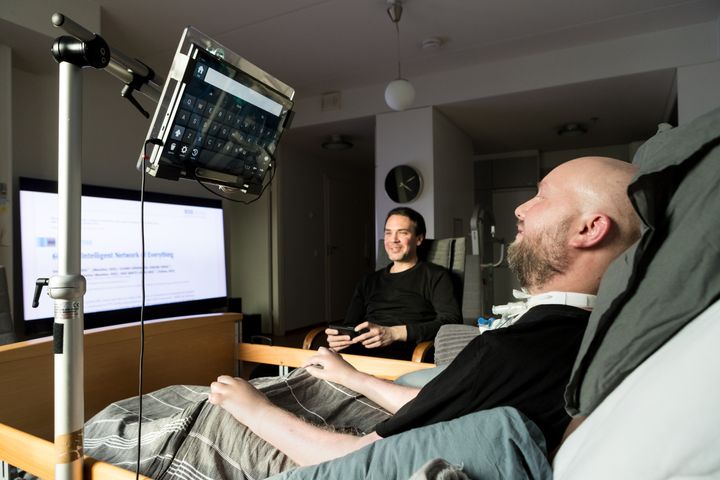Harri Pennanen - writing the future of 6G, one blink at a time
There are researchers who define their field, and then there are those who, by force of intellect and persistence, redefine what is possible. Harri Pennanen, a Postdoctoral Researcher at the University of Oulu's Centre for Wireless Communications (CWC), belongs to the latter category. His recent work, the most comprehensive survey of 6G technology to date, not only pushes the boundaries of wireless communication but also embodies resilience, the disciplined pursuit of knowledge despite constraints, and the refusal to accept imposed limitations.

Harri Pennanen’s research career began conventionally enough. “I became interested in wireless communication during the final stages of my master’s studies when working at Digita as a summer trainee in the mid-2000s. I completed every available wireless communication course and applied for a master’s thesis position at the CWC. While working on my thesis, it became clear that I wanted to pursue a research career in telecommunications. The path has continued ever since,” Pennanen reminisces.
Diagnosed with ALS, a disease that strips away physical ability with ruthless inevitability, Pennanen refused to withdraw. Instead, he adapted. The world in which he operates has become smaller in a physical sense, but his intellectual reach has continued to expand. His latest achievement, 6G: The Intelligent Network of Everything, an IEEE Access paper that came out in January 2025, distils years of inquiry into the evolution of wireless networks. It is a milestone in 6G research. It tracks the transition from 5G to 6G and interrogates the very premise of connectivity itself.
As Pennanen explains it, “6G is envisioned to evolve toward the Intelligent Network of Everything, enabling a smart wireless world where networks are no longer merely channels for data transmission but function as dynamic, context-aware systems that interact with their surroundings, enhancing decision-making and automation. From a researcher’s perspective, envisioning the future is captivating. It places you at the forefront of research and allows you to be a trailblazer. Finnish 6G research has been a global pioneer from the very beginning.”
The paper is a 6G research landmark because of the questions it forces the wireless field to confront. At over 100 pages, it lays out a 6G architecture centred around ubiquitous AI, among other key innovations. It integrates intelligence at every level of the network, from devices to the core, and draws attention to the forces shaping what comes after.
"What excites me most is the paper's novel and far-reaching vision for 6G and beyond," Pennanen says. "It lays out a clear evolutionary path from 1G to 6G, and, most excitingly, it introduces what is arguably the world's first 7G vision."
Where much of the field concentrates on incremental improvements, Pennanen and his co-authors apply a broader lens. They examine how wireless networks will go beyond telecommunications into automation, intelligence, human interaction, and society’s structures at large. The paper’s scale and ambition make it a necessary reference—one that others in the field will have to engage with, whether to build upon its conclusions or to challenge them. It asserts the terms by which the future of wireless networks will be understood.
While ALS has taken his ability to move, speak, and even breathe unaided, technology has become his bridge—keeping him connected to his work, his research, and the world. An invasive ventilator sustains his life while an eye-tracking computer turns his gaze into words, analysis, and discovery. This is inspiring on a personal level, but it also showcases the transformative power of assistive technology and, most importantly, the boundless adaptability of the human spirit.
"Doing research with ALS has required lots of sisu, a ‘never give up’ attitude. It also requires high motivation, a positive mindset, and a good sense of humour," Pennanen describes. For him, adaptation is essential.
Harri Pennanen’s presence at CWC has been defined by contribution. His collaborations with colleagues like Tuomo Hänninen, Oskari Tervo, and professors Antti Tölli and Matti Latva-aho have offered him intellectual exchange at the highest level. “In recent years, I put everything into the 6G paper,” Pennanen says. “Going forward, my focus will be on beyond 6G topics and, hopefully, expanding collaborations.” That he works remotely, that he operates under conditions unimaginable to most, is not what defines him. It’s part of his story.
For all the technical significance of his work, it is Pennanen’s perspective on adaptation that lingers. He has said that rather than focus on what is lost, he focuses on what remains possible. It is this mindset that allows him to engage with research not as an observer of the field but as one of its architects. His ability to think, to create, and to see the long arc of wireless technology’s evolution remains intact, sharper perhaps for the narrowing of external distractions.
If there is a message in his story, it is that constraint does not equate to irrelevance. That adaptation is not a secondary skill in research but a core principle. That the future of technology is shaped not only by those with the most resources, the fastest processors, or the most optimised tools—but by those who refuse to stop thinking forward.
Harri Pennanen does not ask for recognition, nor does he need it. His work ensures that his influence will persist in the foundations of the networks to come. If the publication "Intelligent Network of Everything" is the future that unfolds, it will carry his intellectual fingerprints in ways more lasting than any individual contribution. In that sense, his impact is already assured.
Read this article and many more in the 10th issue of 6G Waves, coming out on 3rd June!
Avainsanat
Yhteyshenkilöt
Ville WittenbergCommunications Specialist
Science communications: information technology and 6G Flagship programme
Kuvat

Tilaa tiedotteet sähköpostiisi
Haluatko tietää asioista ensimmäisten joukossa? Kun tilaat tiedotteemme, saat ne sähköpostiisi välittömästi julkaisuhetkellä. Tilauksen voit halutessasi perua milloin tahansa.
Lue lisää julkaisijalta University of Oulu
Building Resilience into Networks - 6G Flagship’s 15th White Paper24.11.2025 09:53:37 EET | Tiedote
Resilience in 6G is a critical design objective. It connects reliability, security, and adaptability into one framework that allows networks to withstand, recover, and evolve through disruption.
Multibeam antennas to play an important role in 6G27.5.2025 07:07:00 EEST | Tiedote
Professor Yingjie Jay Guo is the Director of Global Big Data Technologies Centre at University of Technology Sydney. He has over thirty years of international academic, and industrial experience. We sat down with him to discuss about the role of antennas in the future of 6G development.
6G test centre´s strategic role – pioneering dual-use innovation within NATO DIANA21.5.2025 09:09:00 EEST | Tiedote
The 6G Test Centre (6GTC) in the University of Oulu is at the forefront of dual-use innovation. It leverages the Arctic's extreme conditions to push the boundaries of 5G and 6G validation. Also, 4G testing is available. The centre addresses critical challenges in the defence and commercial sectors by integrating AI-driven network optimisation and seamless network transitions.
Sustainable exploration for green transition in mining industry8.5.2025 09:30:30 EEST | Tiedote
Critical raw materials are fundamental to feeding the EU industrial value chains and strategic sectors and the green energy transition. SEMACRET project, led by the University of Oulu Finland, promoted sustainable exploration for green transition critical raw materials in the EU, securing the continued supply for its industries.
Breakthrough in multifunctional solar cells13.3.2025 08:15:00 EET | Uutinen
A recent article published by the research team led by Associate Professor Yang Bai from University of Oulu is highlighted as the back cover on the journal of Advanced Electronic Materials.
Uutishuoneessa voit lukea tiedotteitamme ja muuta julkaisemaamme materiaalia. Löydät sieltä niin yhteyshenkilöidemme tiedot kuin vapaasti julkaistavissa olevia kuvia ja videoita. Uutishuoneessa voit nähdä myös sosiaalisen median sisältöjä. Kaikki tiedotepalvelussa julkaistu materiaali on vapaasti median käytettävissä.
Tutustu uutishuoneeseemme